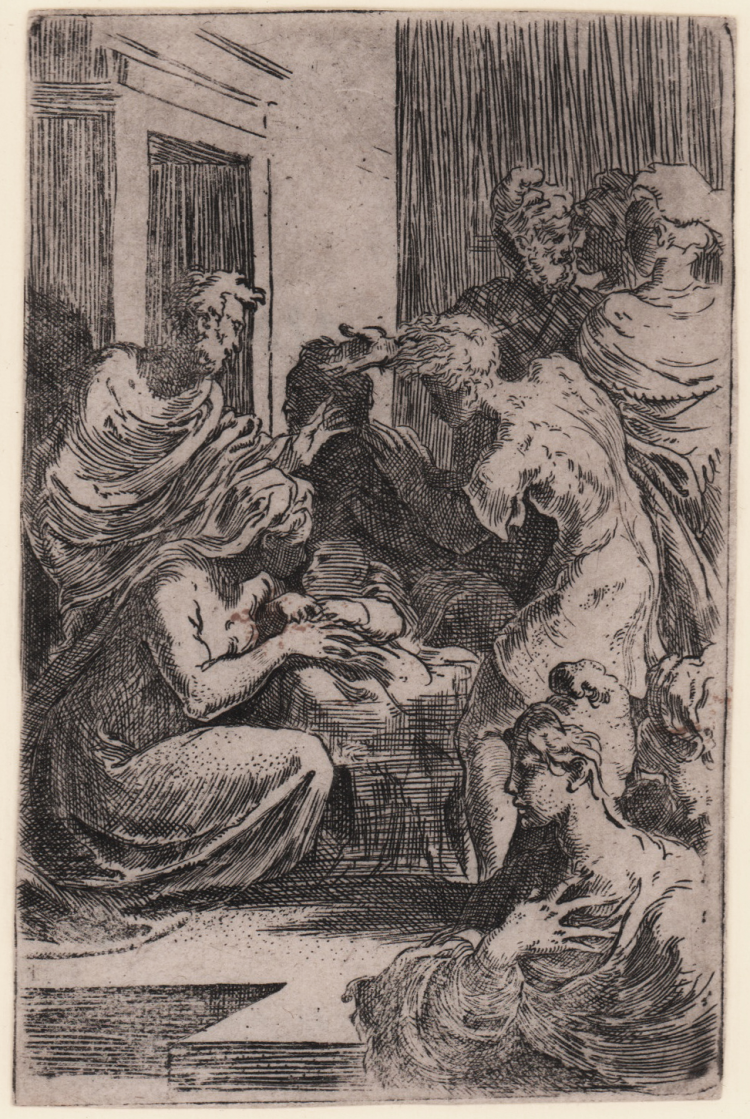




| Reference: | S30418 |
| Author | Francesco Maria Mazzola detto PARMIGIANINO |
| Year: | 1526 ca. |
| Measures: | 78 x 121 mm |



| Reference: | S30418 |
| Author | Francesco Maria Mazzola detto PARMIGIANINO |
| Year: | 1526 ca. |
| Measures: | 78 x 121 mm |
Etching and engraving, 1526 ca. Example of the first state of two described by Mistrali.
A fine proof, printed on contemporary laid paper, trimmed to the platemark, in perfect condition.
In Rome between 1524 and 1527, Parmigianino made a number of drawings that explored the composition of an Adoration of the Shepherds, probably in preparation for the horizontal composition engraved by Jacopo Caraglio in 1526.
This work, as noted by A. Gnann, may be related with two preparatory drawings: one at Windsor (Popham, n. 644), in which there are two women in the foreground, but the scene of the slightly changed, and a second at Staatsgalerie, Stuttgart Stuttgart (Popham, n. 593), which corresponds to the etching in the cut and size, but shows two men in the foreground.
Moreover, the Louvre is conserved a pen drawing (Popham, n. 368) with a sketch for the figure of Mary and Child.
The Adoration of the Shepherds, is connected directly with The Marriage of Maria of 1525.
In both cases, in fact, Parmigianino moves the main event in the second floor and increases the tension by inserting in the foreground figures larger.
Compared to Marriage, however, here the movements are more dynamic and are connected to each other through a chiaroscuro more rich in contrasts.
Compared to the two etchings of 1524-1525 of the Entombment of Christ, where the artist uses elongated lines on figures as to create a very thin network, here the lines are shorter and accentuate the plasticity of bodies.
The movements don’t flow over into each other and due to the richer contrast, the architectures also stand out clearly. The same stylistic features are found precisely in the engraving of Caraglio, so the dating of this work can be traced.
Collection marks of: Fransz Gawet (Lugt 1069)
J.E. WETTERAUER (Lugt 3183)
V. Blum (sconosciuto al Lugt)
A great example of this important work by Parmigianino.
|
Mistrali, Parmigianino Incisore, 15 I/II; Bartsch xvi, 3; T.I.B. 32, 7 (10); A. Gnann in “Roma e lo stile classico di Raffaello 1515-1521, p. 381 n. 285; A. E. Popham, Catalogue of Drawings by Parmigianino, 1971, p. 183, no. 593 and p. 210, no. 728.
|
Francesco Maria Mazzola detto PARMIGIANINO (Parma 1503 – Casal Maggiore 1540)
|
Italian painter, draughtsman and printmaker. Beginning a career that was to last only two decades, he moved from precocious success in the shadow of Correggio in Parma to be hailed in the Rome of Clement VII as Raphael reborn. There he executed few large-scale works but was introduced to printmaking. After the Sack of Rome in 1527, he returned to northern Italy, where in his final decade he created some of his most markedly Mannerist works. Equally gifted as a painter of small panels and large-scale frescoes both sacred and profane, he was also one of the most penetrating portrait painters of his age. Throughout his career he was a compulsive draughtsman, not only of preparatory studies for paintings and prints, but also of scenes from everyday life and of erotica.
|
|
Mistrali, Parmigianino Incisore, 15 I/II; Bartsch xvi, 3; T.I.B. 32, 7 (10); A. Gnann in “Roma e lo stile classico di Raffaello 1515-1521, p. 381 n. 285; A. E. Popham, Catalogue of Drawings by Parmigianino, 1971, p. 183, no. 593 and p. 210, no. 728.
|
Francesco Maria Mazzola detto PARMIGIANINO (Parma 1503 – Casal Maggiore 1540)
|
Italian painter, draughtsman and printmaker. Beginning a career that was to last only two decades, he moved from precocious success in the shadow of Correggio in Parma to be hailed in the Rome of Clement VII as Raphael reborn. There he executed few large-scale works but was introduced to printmaking. After the Sack of Rome in 1527, he returned to northern Italy, where in his final decade he created some of his most markedly Mannerist works. Equally gifted as a painter of small panels and large-scale frescoes both sacred and profane, he was also one of the most penetrating portrait painters of his age. Throughout his career he was a compulsive draughtsman, not only of preparatory studies for paintings and prints, but also of scenes from everyday life and of erotica.
|